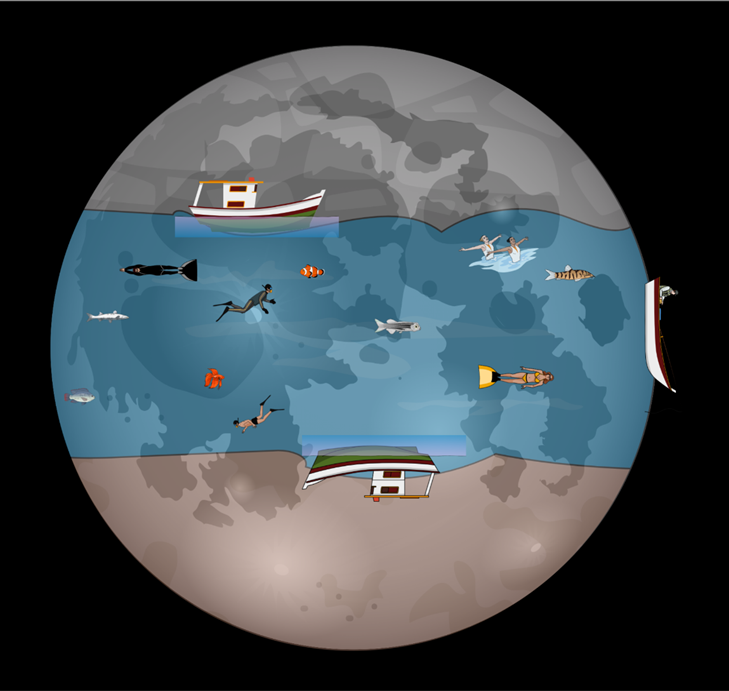All right, all right, maybe I exaggerate a little bit in the picture above – a huge amount of water, fishes, boats, and swimmers having a good time in a moon river.
But all I was trying to say is that on October 26, 2020, Nature Astronomy published a study affirming that they have detected water in the Moon. Actually, it was not any water, it was molecular water – the smallest unit of it.

The study affirms to have detected water in certain craters of the Moon through an infrared camera named FORCAST connect to the telescope SOFIA on August 31, 2018.
The camera detected a strong 6µm emission band, which was compared to other studies and to the literature values confirming the validity of the data.
A simple explanation about the infrared analysis is that it comprehends a wide range of the electromagnetic spectrum, from 14000 to 10 cm−1 which is basically a measurement of energy, and how it interacts with matter.
That interaction can be by absorbing, emitting, or reflecting some level of energy. This measurement can identify not only an unknown molecule but also the characteristics of it.

The strong 6µm emission band detected by FORCAST is from a specific region of the infrared bandwidth, the mid-infrared, from 4000 to 400 cm-1.
This portion is usually used to observe and analyze fundamental vibrations associated with molecular structure. It is possible to analyze substances in any form – solid, liquid, or gaseous.
As such molecule’s vibrations are widely used to study molecular structures, it is known that a very single molecule could absorb, emit, or reflect energy in a certain frequency that matches specific structural characteristics.
This happens because molecules are not static objects, their chemical bonds between atoms are in constant motion, they are dynamic and interact with different levels of energy.
For example, the water molecule can vibrate in three different ways. Two of them are elongation and stretch of the oxygen-hydrogen bond, and the other one is angular deformation.
Ok, let’s take it easy now: the water molecule has two bonds, right? Yes.
Those two can move in a symmetric way, with ups and downs simultaneously, and in an asymmetric way, where one bond is up while the other one is down.
These two types of vibrations are the symmetric stretch and asymmetric stretch. The third vibration is not an up or down movement, is more like, an angular movement, like a swing, called symmetrical deformation.

If you want to see gifs for a better understanding of what kind of vibration the molecule has, you can check it out by clicking on its names above in the text.
Now let’s get back to the article.

The strong 6 µm emission band was observed in a specific area of the Moon, in the Clavius crater and the surrounding terrain located in high latitude levels.
To make sure that they were really looking at an H2O infrared band, scientists used previous data of water-bearing materials to confirm the properties of the lunar band; they also examined the planet’s existing material to see the 6 µm H2O band and compare it to the band detected. Based on these comparisons, they confirmed the band to be from molecular water.
However, this band was not the only one detected in the Moon surface. Another 3µm absorption band was detected, and it can mean more water.
This second band was present near the Moon’s equator region, in a different location from the first band.
So, it seems like the location changes a lot in the data collected by scientists.
Differently from the 6µm which is a very characteristic band of the water molecule, this 3µm band represents one molecule that could turn it into water, the hydroxyl (O-H).
Meaning that the water can also be formed from chemical conversion reactions from hydroxyl into the water on the moon surface.

You may ask, “how is it possible to have water in the moon surface?” Or even “Where the water came from?” Well, in the article they have a theory.
“There are several mechanisms for the origin of water in lunar soil that is relevant to our data,” says the article, and also: “Water present in the lunar exosphere can be chemisorbed on grain surfaces.
Water can be introduced by volatile-rich micrometeorites, and a portion of this water can be retained in the glasses resulting from these impacts or introduced into the exosphere, available for chemisorption”(HONNIBALL et al., 2020).
In other words, the water can come from micro-meteorites, and when they crush on the moon surface the molecules get retained in something the scientists called glasses and grain surfaces.
As such, the results of the published article concludes in a consistent way that there is an existing mechanism that produces water in the moon surface by impact.
But unfortunately, the progression of this process is very little/tiny/small and maybe we are never going to see a swimming competition on the Moon. Sorry people, we have to settle for our normal pools, beaches, rivers, and oceans.
If you want to read the full article and get more information about, here is it:
HONNIBALL, C. I. et al. Molecular water detected on the sunlit Moon by SOFIA. Nature Astronomy, p. 1–7, 26 out. 2020.
Now if you want to do a cool picture like those you have seen here, you can try to Mind the Graph! Mind the Graph is a platform that allows you to present your research project, digital content in a more visual and attractive way, try to Mind the Graph! Click here to start using it.
And if you are a chemist like me, you can use the Chemistry gallery in your work, no more suffering for creating molecules, you can have here beautiful molecules and structures. Check Mind the Graph.

Subscribe to our newsletter
Exclusive high quality content about effective visual
communication in science.




